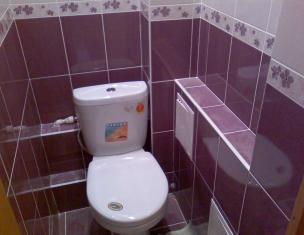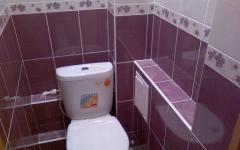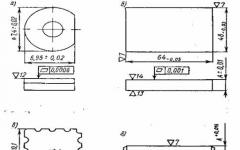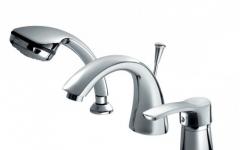Thin wall tiles can be cut with a conventional glass cutter. General rules:
- the tile is laid with the glazed surface up on a flat hard surface
- a metal ruler is superimposed on the cut line
- the glass cutter with strong uniform pressure is led along the ruler from the far edge of the tile towards itself. The pressure must be sufficient to cut through the glaze and notch the ceramic base of the tile. The glass cutter must not be cut twice or more times: the cut must be made in one pass.
- the incised tile is laid along the notch line on the edge of the table and its free end must be strongly pressed by hand. The tile will break along the notch line, after which the resulting edges must be cleaned with an abrasive tool
Similarly, you can cut the tile with a turning tool with a cutting edge made of Pobedite or other hard alloy.
Mechanical tile cutter
Working with a manual glass cutter requires good skills and an accurate eye. Therefore, when performing tile work, it is better to use a mechanical tile cutter. It consists of a base on which the tile is attached, and a guide along which the carriage moves with a cutter fixed in it (analogous to a glass cutter). The cutter is pressed against the tile by a lever, so the cutting force is much greater than with manual cutting. Also, by acting on the tile with a lever, it can be broken along the incision made, which is more convenient than “on the edge of the table”
Using a mechanical tile cutter, you can cut not only wall tiles, but also floor tiles.
With the help of a tile cutter or a glass cutter, it is impossible or very difficult to cut a strip less than 1 cm wide from a tile. Reduction of a tile by such small values is carried out using special nippers. They seem to “bite off” pieces of the tile, sometimes making complex, curved surfaces along its end. For this, a modification of nippers with curly sponges is used.
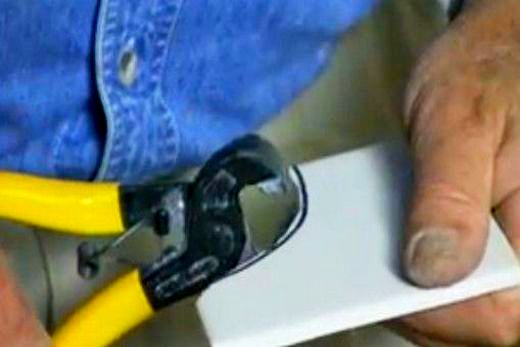
"biting" tiles with wire cutters
Power Tool
Electric tile cutter
This is a kind of circular saw on a stationary base and with a diamond cutting wheel. They use it like a conventional circular saw: the tile is pressed against the surface of the workbench, the cutting line is brought to the diamond wheel and, moving the tile forward, it is sawn into two parts or a blind cut is made in it.
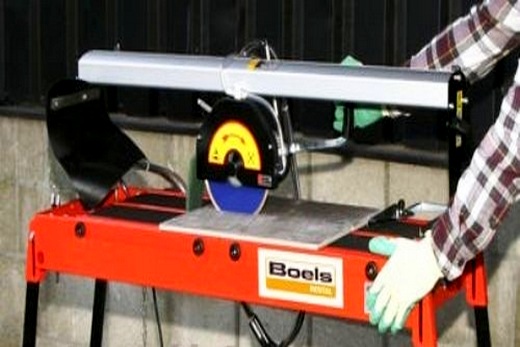
The diamond wheel needs intensive cooling and lubrication, so the design of this device provides for baths with water and other methods of cooling. Do not forget to change the water while working.
An electric tile cutter allows you to make long, straight lines. A grinder with a diamond wheel does not have such accuracy, but it is more convenient to use it and it can cut out all kinds of grooves, make beveled edges, etc. For example, when cutting a groove with a grinder, first two blind cuts are made along the depth of the groove from the ends of the tile, and then from above, at the ends of these cuts, a layer of glaze and a little bit of a ceramic base are sawn through. Cut from two sides and trimmed from the third piece of tile breaks out.
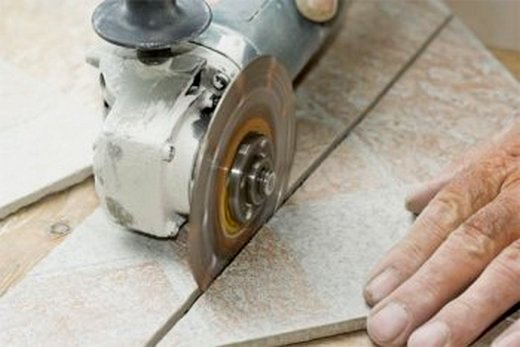
Cutting tiles with a grinder
Caution is required when working with a grinder. The diamond wheel is fragile, the slightest distortion in the cut groove leads to its breakage with the formation of many injuring fragments. Do not try to cut curved grooves with a grinder, change the inclination of the tool during operation. Use a protective cover, goggles.
Electric drill
An electric drill for drilling tiles is used both with drills of a regular shape and a special configuration: for example, with a spear-shaped cutting part or nozzles with diamond chips.
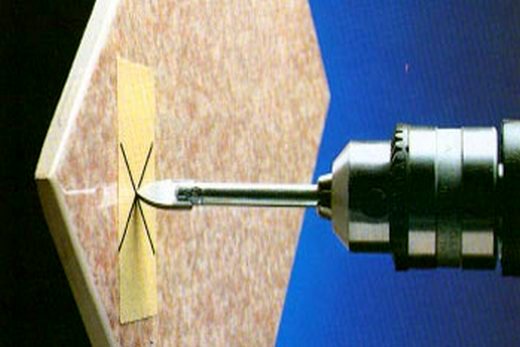
Drilling tiles with a lance drill
The difficulty in drilling tiles arises from the sliding of the tip of the drill over the glaze in the first moments of drilling. To avoid this slipping, strips of adhesive tape are glued crosswise to the place where the hole is to be made. They will not only prevent the drill from slipping, but also protect the tile from cracking.
Sometimes the tile is punched at the drilling point, but the core is not held perpendicular to the tile, but at an angle of 45º - otherwise the tile will crack upon impact.
Instead of a drill, you can use a puncher, but its mechanism should not work “on impact” - only on rotation: otherwise the tile will crack.
Holes of larger diameter are made using a "hole saw" or "ballerina drill".
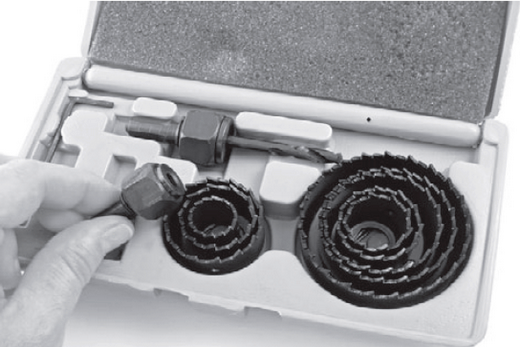
Hole saw set with central drill
A hole saw, which would be more correctly called a cutter, is a hollow cylinder, the lower part of which is equipped with cutting edges - miniature cutters. Its upper part is equipped with a shank, which is clamped in the spindle (chuck) of the electric drill.
During rotation, such a saw cuts an annular groove in the tile with its cutting edges, after which the cut ceramic circle falls out and a hole is obtained in the material.
Often a hole saw is combined with a central drill, which is longer than the cutting cylinder and is used to fix the tool at the desired point on the tile.
The “ballerina drill” is a central rod with a pointed end, which is fixed in the center of the intended circle, and a cutter placed on the bracket, which, when the ballerina rotates, cuts a circular groove in the tile. Readers have repeatedly observed an analogue of such a “ballerina” in crime films: glass circles are cut out near the locking devices on the windows with such devices when entering an apartment. Only the central rod of the criminal "ballerinas" is equipped not with a point, but with a suction cup.
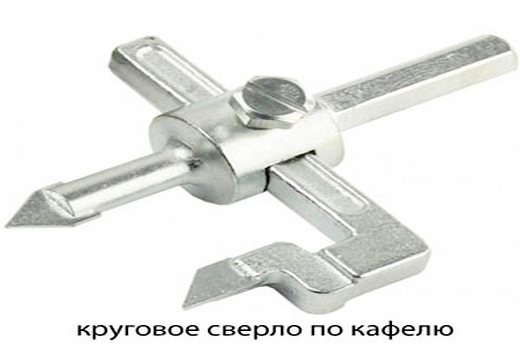
Ballerina drill
Since the cutter can move along the outboard bracket, you can make holes in tiles of any diameter with a “ballerina” (within the length of the bracket, of course).
Finally, holes of any configuration can be made in the tile, incl. oval, rectangular, etc. This is done as follows: on the tile, a contour of the future hole is drawn with a marker or felt-tip pen, and many holes are made along this line with a thin drill, with minimal jumpers between them. Then the “drilled” part of the tile is carefully broken out, and the uneven edge of the resulting hole is polished with an abrasive tool.
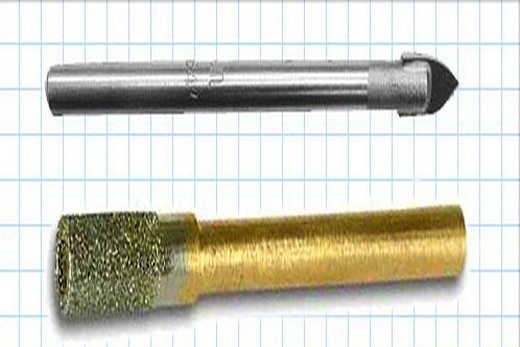
Spear drill and bit with diamond grit
Another way to cut an irregularly shaped hole is to use a grinder or tile cutter. As in the previous case, the contour of the hole is outlined, then a grid is applied inside this contour with a felt-tip pen or pencil, approximately like on a sheet of a notebook in a box, only even smaller. The smaller the step, the better.
Then, with a grinder or tile cutter, the surface of the tile inside this contour is excised. In this case, it is necessary to ensure that the cutting tool does not go beyond the limit line. Then the excised part of the tile breaks out and a hole with stepped edges is obtained. "Steps" are cleaned with an abrasive tool.
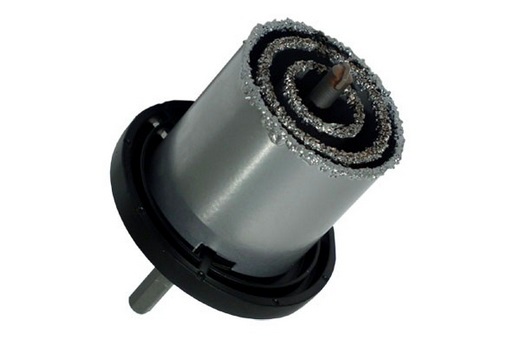
Hole saw with abrasive coating



